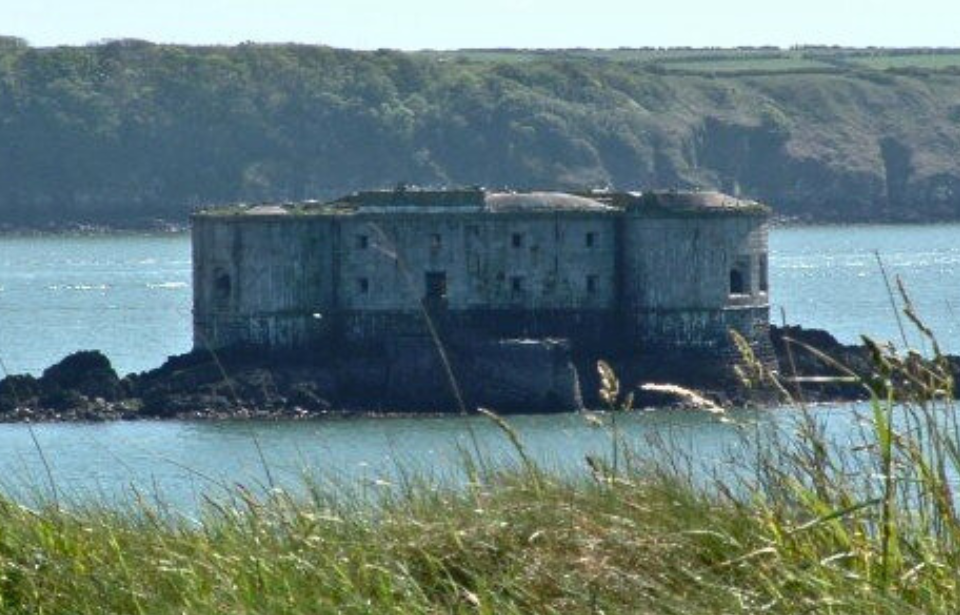Just off the western coast of Wales near Milford Haven lies the imposing Stack Rock Fort. This island fortress was designed as a fortification against potential invasions by sea. Its strategic location in the middle of the waterway made it an ideal point for controlling access to the estuary, a crucial factor during times of conflict and trade. It was part of a broader network of forts and batteries along the coast intended to protect Britain from seaborne threats, and its completion marked a significant enhancement in the military readiness of the region, reflecting the strategic importance of Milford Haven as a naval outpost.
The evolution of Stack Rock Fort from 1539 to 1852

The idea of fortifying Stack Rock dates back to 1539 when Thomas Cromwell suggested bolstering the Milford Haven Waterway’s defenses. However, it wasn’t until the threat of Napoleon III in the mid-1800s that the fort came to fruition. Completed in 1852, Stack Rock Fort was a critical component of Britain’s coastal defense during a time of heightened military tension. The construction process involved numerous challenges, including transporting heavy materials and manpower to the isolated rock.
Over the years, Stack Rock Fort underwent several modifications to adapt to advances in military technology and changing strategic requirements. The initial armaments and defenses installed in the 1850s were periodically updated to incorporate more sophisticated weaponry and to improve the living conditions for the garrison stationed at the fort. These updates ensured that Stack Rock Fort remained an integral part of the coastal defense system well into the late 19th century.
Stack Rock Fort’s defensive design

Originally equipped with three 32-pounder guns and later enhanced with rifled muzzle loader guns, the fort’s military architecture was formidable. A significant upgrade in 1870 expanded its capabilities, allowing it to house a garrison of up to 175 troops. Despite its de-arming in 1929, the fort’s structural integrity and historical layers remain intact, with its design reflecting the typical Victorian military architecture, with thick walls and strategic gun placements designed to withstand or deliver significant firepower.
The architectural design of Stack Rock Fort not only focused on defense but also on sustainability and the well-being of its garrison. The fort included provisions for water collection and storage, barracks for troops, and even a small medical facility. These features made it possible for the fort to function autonomously during extended periods of military engagement, further underscoring its importance as a self-sufficient military installation.
The fort’s transition from military might to private ownership

After serving its purpose as a military fortification, Stack Rock Fort was decommissioned and entered the private market. Its journey through various owners reflects the challenges of maintaining such a unique property. Initially sold for a mere £160 in 1932, its value and potential as a historical site have been re-evaluated in recent years. The fort’s unique position and historical value have attracted attention from historians, conservationists, and those interested in the preservation of military heritage.
The transition from a strategic military fort to a privately owned historical monument has not been without its challenges. The fort’s isolated location and the cost of maintenance have made it difficult for consecutive owners to fully utilize the potential of the property. However, the increasing interest in historical and military architecture has sparked discussions about the best ways to preserve such unique structures while making them accessible to the public.
Plans for community access and preservation

Recently acquired by a private buyer, there are hopeful plans to transform Stack Rock Fort into a ‘living ruin’ accessible to the community. This initiative aims to preserve its historical essence while providing a unique exploration space for history enthusiasts and visitors. Efforts are being made to ensure that the fort can be maintained without losing its historical character, balancing conservation with accessibility.
More from us: London’s Abandoned World War II-Era Tunnels Could Be Getting a New Lease On Life
The vision for Stack Rock Fort includes not only preserving the structure but also interpreting its historical significance through educational programs and public tours. These efforts aim to engage the community and visitors in the rich maritime history of the region, making the fort a focal point for cultural heritage tourism. However, currently, Stack Rock Fort is under private ownership and not open to the general public without prior arrangement.
